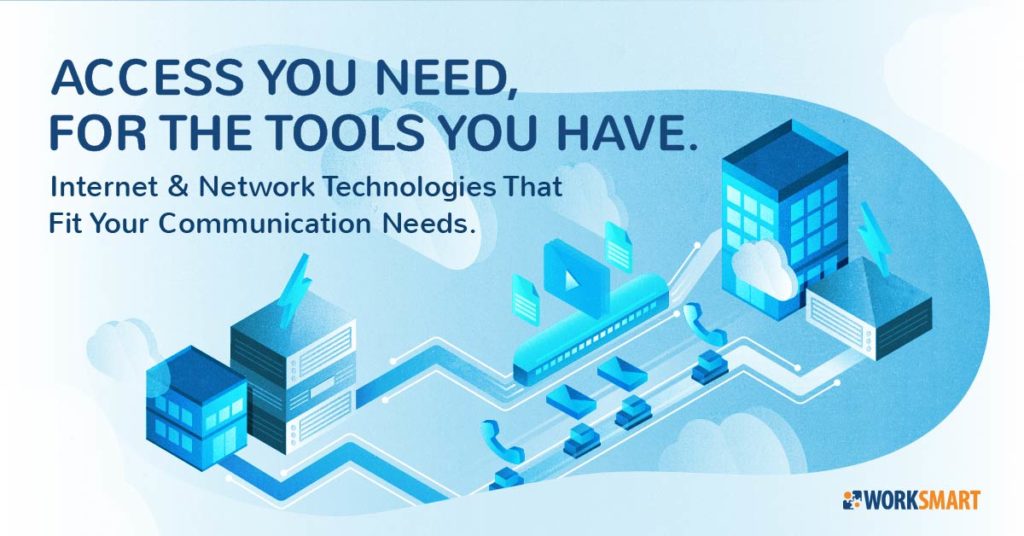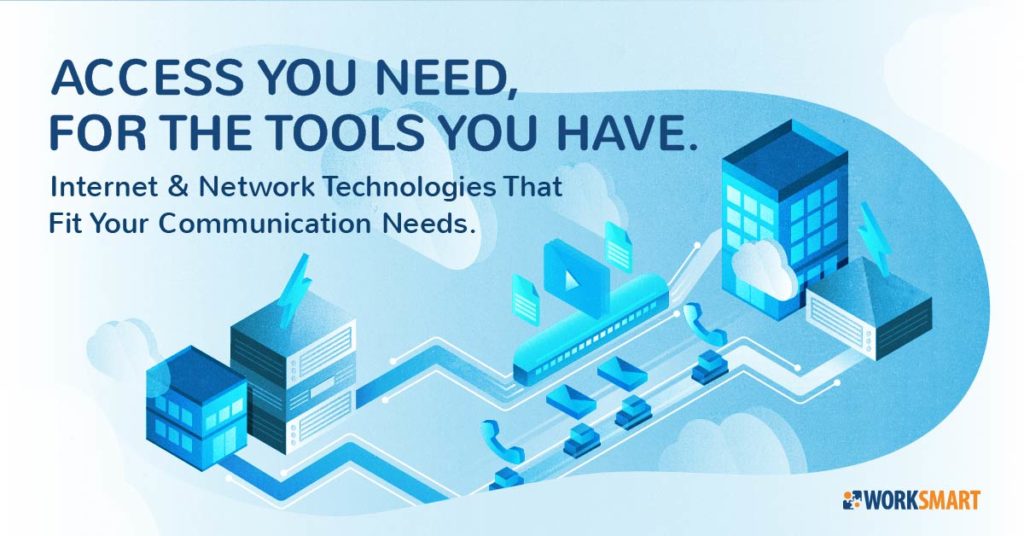We’re talking all about communication this summer. We have more tools to communicate than we have time to use right now. And sometimes you may have noticed a choppy VoIP call, or a pixelated video conference, or a slowdown in cloud-based apps that are important for you to do your job.
That’s why our first communications overview is all about ACCESS.
Your access to the internet, access to your network, and the technology you should be thinking about. Without the right access for your organization, your communications tools may not let you get your message across.
Scroll on for details on choosing an ISP, an SD-WAN overview, a wi-fi reminder, and access options for remote workers.
Choosing an internet service provider (ISP)
No one loves to shop for an internet service provider. We know. The ISP you chose last year may not be right for your growing company today. Or there may be a new option or better pricing in your area. We’ve helped so many organizations determine the best connection for their needs and evaluate all their options, that we’ve become experts. If you think it’s time to consider switching up your ISP, here’s what you should consider:
- First thing’s first: are you under an existing contract with your current provider? Check on it—a typical ISP will require you pay out the remainder of your contract to leave early.
If you’re free to shop around, we will research your street address to confirm which ISPs have fiber or coax service available. Keep in mind, if your building doesn’t already have fiber or coax in use, an ISP may take from 30 days (for coax) to 90 or 120 days (for fiber) to install.
• Talk to us about bandwidth needs. Will you be running voice traffic and data over your ISP connection? Or just data? What’s your tolerance to internet down time? For most organizations, it’s really low. So we recommend a backup coax connection with SD-WAN capability (more on that next) so your network has redundancy in case of an ISP failure and better routing.
• Coax providers offer month to month agreements, but fiber connections usually require a 24-36 month contract. We recommend the shortest term possible so you can check out new or less-expensive options that may enter the market.
• Use our expertise and relationships with channel partners to make sure you’re getting the best installation dates or outage issues during your term.
SD-WAN
SD-WAN is an acronym for software-defined wide area network. As more of our applications move to the cloud, users can experience slowdowns accessing critical apps (ex. SalesForce) or poor-quality VoIP calls. SD-WAN is a simple solution to optimize VoIP call quality, internet service quality, and bandwidth. And organizations with multiple sites can save Internet costs and increase performance in locations with fewer options.
We partner with BigLeaf, the leader in internet and cloud optimization SD-WAN.
Cloud-first SD-WAN allows us to automate the optimization of your VOIP call quality, internet service quality, and bandwidth. It intelligently adapts to changing Internet problems and application needs.
That means we can prioritize the apps and sites that are critical to your business in case of bottlenecks. And you won’t experience any choppy or dropped VOIP calls.
• VoIP: a big benefit for our clients is protecting VoIP calls from drops, choppy sound issues, and echos. It prioritizes VoIP and routes calls over the cleanest ISP connection at any moment in time.
• Automatic failover: SD-WAN also adds auto-failover, and Dynamic QoS to existing VPNs for better reliability and performance.
• Prioritized traffic for important apps<: SD-WAN automatically identifies your SaaS traffic (and other cloud apps) to ensure that it gets prioritized appropriately. Your co-worker’s YouTube video won’t slow down your Salesforce session.
• Monitoring: Bigleaf monitors each Internet connection from your office to the core of the Internet 10 times per second, across the exact same paths that all of your data travels. This end-to-end monitoring typically covers over 98% of the path from your office to your Cloud applications.
• Control: Bigleaf routes all of your traffic via their redundant Gateway Clusters collocated in datacenters called “Carrier Hotels”. These locations ensure you have the lowest possible latency. and give 100% control of the routing and QoS prioritization of your traffic.
• Security Bigleaf drops-in between your firewall and your ISP connections, optimizing traffic while your firewall handles security and VPNs. So you can keep using your security solutions and add SD-WAN benefits for your traffic.<>
For IT professionals, here’s a video explaining optimized cloud access.
Wi-fi Reminder
A few months ago we shared a blog post on setting up secure guest wireless, and it’s a good reminder as we talk about access this month. Wi-fi security is easy to overlook, but your end users and your guests rely on your security when they’re using it to access the Internet.
ACCESS OPTIONS FOR REMOTE WORKERS
Most of our clients use a VPN (virtual private network) to create a secure connection between the organization’s network resources and a remote computer. Because the connection is encrypted, users may experience slower speeds when passing big files back and forth from the office network. If more than a few users from your organization are accessing the VPN, or if they often work with large files, your organization needs a remote desktop solution.
Employing a remote desktop through the VPN to a terminal server can give multiple people a desktop-like experience from their remote location. Users securely connect through a VPN, but all the work is happening on-site at the terminal server. The remote users don’t have to wait for files to pass back and forth, instead they see the results quickly—almost like watching a video stream of their remote desktop. And connecting to a terminal server without logging in to the VPN? We don’t recommend that setup as it leaves your organization’s network open for hacking.
What if an employee doesn’t have a laptop, and needs to access their desktop workstation from another computer? You can use LogMeIn to remotely access that one machine.
And if you have executives or virtual employees who need a simple always-on solution to securely working remotely, we recommend Sophos RED. This is Sophos’ Remote Ethernet Device, which turns any location into a secure location. It extends a secure network from your main office to remote locations without the need for difficult configurations or end-user login frustration. It’s easy to setup remotely, and updates are automated.
Have questions? Let us know.



